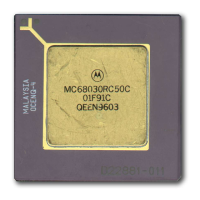Bus Operation
MOTOROLA
MC68030 USER’S MANUAL
7-5
7.1.4 Data Bus
The data bus signals (D0–D31) comprise a bidirectional, nonmultiplexed parallel bus that
contains the data being transferred to or from the processor. A read or write operation may
transfer 8, 16, 24, or 32 bits of data (one, two, three, or four bytes) in one bus cycle. During
a read cycle, the data is latched by the processor on the last falling edge of the clock for that
bus cycle. For a write cycle, all 32 bits of the data bus are driven, regardless of the port width
or operand size. The processor places the data on the data bus one-half clock cycle after
AS
is asserted in a write cycle.
7.1.5 Data Strobe
The data strobe (DS) is a timing signal that applies to the data bus. For a read cycle, the
processor asserts DS
to signal the external device to place data on the bus. It is asserted at
the same time as AS
during a read cycle. For a write cycle, DS signals to the external device
that the data to be written is valid on the bus. The processor asserts DS
one full clock cycle
after the assertion of AS
during a write cycle.
7.1.6 Data Buffer Enable
The data buffer enable signal (DBEN
) can be used to enable external data buffers while data
is present on the data bus. During a read operation, DBEN
is asserted one clock cycle after
the beginning of the bus cycle and is negated as DS
is negated. In a write operation, DBEN
is asserted at the time AS is asserted and is held active for the duration of the cycle. In a
synchronous system supporting two-clock bus cycles, DBEN
timing may prevent its use.
7.1.7 Bus Cycle Termination Signals
During asynchronous bus cycles, external devices assert the data transfer and size
acknowledge signals (DSACK0 and/or DSACK1) as part of the bus protocol. During a read
cycle, the assertion of DSACKx
signals the processor to terminate the bus cycle and to latch
the data. During a write cycle, the assertion of DSACKx
indicates that the external device
has successfully stored the data and that the cycle may terminate. These signals also
indicate to the processor the size of the port for the bus cycle just completed, as shown in
Table 7-1. Refer to
7.3.1 Asynchronous Read Cycle
for timing relationships of DSACK0
and DSACK1.

